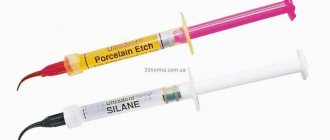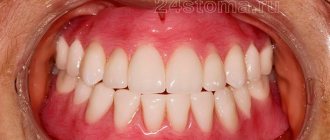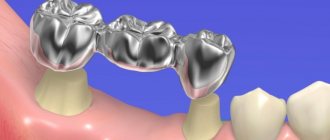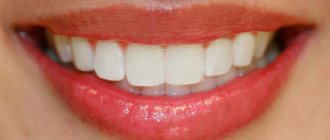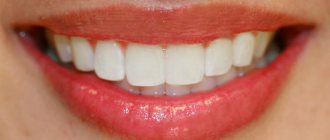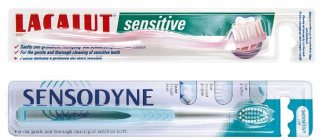Types of composites
According to the curing method there are:
- chemically curing (paste - paste, powder - liquid);
- light-curing (photopolymers).
The consistency of the initial paste-like composite depends on the amount of filler and dispersion. There are pastes of high viscosity (packable and dense), as well as low (fluid). Most materials use fillers with average particles with a diameter of 0.2-3 microns. There are also particles with a diameter of 0.04 microns - microdisperse filler. The proportion of particles that would be even smaller ranges from a few% to 35%. Recently, varieties of composites with nanofillers with a size of 1-10 nm have appeared.
Possible applications of flowable composites
1996 was a special year, because it was in this year that flowable composites were developed, which can be said to change the entire development of adhesive dentistry.
The first generation of flowable composites was developed to simplify their placement and expand the range of possible applications in clinical practice. The first flowable analogues consisted of filler particles identical to those in a conventional hybrid composite, while the number of such particles was reduced, and the number of diluent monomers was, on the contrary, increased. Thus, it was possible to achieve fluctuations in viscosity and fluidity parameters, as well as certain handling characteristics that made these materials ideal for everyday practice. Manufacturers have presented flowable composites as materials suitable for a wide range of applications, including all classes of anterior and distal restorations, restoration of amalgam margins, block-out provision, repair of composite and ceramic restorations for core formation, restoration of crown margins, use as a spacer or sealant, for preventive composite restorations or for easy restoration of the incisal edges of teeth, fixation of veneers, production of composite inlays and onlays, restoration of enamel defects and areas of pores in previously formed restorations.
Unfortunately, the first generation of flowable analogues, taking into account their not very high mechanical characteristics such as bending resistance and wear resistance, was significantly inferior to conventional hybrid composites: in fact, a reduction in the amount of filler in their composition by 20-25% was the reason why they turned out to be definitely no better than hybrid composites. A significant number of mechanical properties of materials largely depend on the filler phase, including compressive strength and/or hardness parameters, flexural strength, elastic modulus, coefficient of thermal expansion, moisture absorption and wear resistance. Thus, reducing the filler content, as reported by Bayne et al, resulted in the properties of flowable composites being only 60-80% of those of conventional composites, which were significantly less flowable. In one scientific study, an example was given that two materials of the same brand and grade, one of which was flowable and the other was a conventional hybrid, differed significantly in most of their mechanical characteristics. Taking this into account, all attempts by doctors to use the first fluid analogues for all purposes proposed by the manufacturer led in many cases to clinical failures or, more precisely, to less effective results than expected. Consequently, in this case, the marketing component played against itself, and clinicians realized that flowable analogues are still not the same classical composites.
Since the past is the best lesson for the future, the formulation of all possible applications of current composites is based on the results of evidence-based research, which determines the specifics of the materials in comparison. Although the physical and mechanical properties of a material do not always directly correlate with the clinical characteristics of their application, in most cases they still influence the prospect of their use in specific clinical situations. The clinical durability parameters of restorations made from certain materials can only be assessed through the necessary clinical studies and appropriate experiments.
New generation of flowable composite materials
Currently, there are many flowable materials that continue to be researched and improved. These composites are a worthy alternative to classical ones with higher viscosity, and further developments are being carried out in order to still achieve the goal of obtaining a composite material with ideal or almost ideal characteristics that would help to maximally imitate the structures of enamel and dentin tissues. Since the mechanical properties of even current restoration materials are approaching the properties of enamel and dentin, the duration of their functioning increases significantly. The ideal restorative material must meet three main parameters: function, aesthetics and biocompatibility. In addition, optimizing the adhesion of the composite to enamel and dentin significantly increases their mechanical strength, marginal adaptation and condensation level, positively affecting the reliability and durability of the restoration. Of course, it is difficult to achieve ideal solutions, but nanotechnology used today helps in achieving the necessary effects and results.
Selection of restoration materials
In the process of selecting the appropriate material for any particular clinical situation, it is necessary to evaluate at least two factors - mechanical and esthetic criteria, with the understanding that there are other variables that influence the prognosis of the future restoration. The doctor must always take into account the technique of introducing the material, the configuration of the cavity, the predicted position of the edges of the filling, the intensity of polymerization, the anatomy of the tooth, occlusion and the level of isolation of the working field. Considering such a huge number of factors, it is quite difficult to choose a specific material, so in the next information block we will analyze at least the main selection criteria that determine the effectiveness of the treatment result.
Mechanical and aesthetic requirements
In composite production technology, the particle size of the filler, as well as the amount of it, influences the characteristics of the material, determining its overall clinical success. Simply put, the mechanical and physical properties of composites improve as the number of filler particles increases. Such properties include compressive strength and/or material hardness, flexural strength, modulus of elasticity, coefficient of thermal expansion, moisture absorption and wear resistance. The aesthetic appearance of the surface of a composite restoration is also a direct reflection of the particle size parameter. Aesthetic restorations require certain optical properties that mimic natural tooth tissue as much as possible. Since the composite does not consist of hydroxyapatite crystals or enamel prisms or dentinal tubules, they must be simulated due to the characteristic behavior of light passing through the restoration, which along this path has time to be reflected, refracted and absorbed. New composite materials have optical properties that make the tooth polychromatic. In addition, the size and distribution of filler particles can influence the color and esthetics of the restoration through the so-called “double layer effect” or the so-called “chameleon effect” or “mixing effect”. This effect is achieved due to the almost similar nature of light transmission through hard tissue and composite restoration, which is practically not disrupted at the composite/dentin (enamel) interface. In addition, the composition and characteristics of the filler particles themselves also influence the surface quality of a composite restoration. In newer forms of filler, the filler particles approach almost nanosize, and improvements in the parameters of shape, orientation and concentration have a positive effect not only on the physical and mechanical properties, but also on the optical characteristics of the restoration. In addition, hybrid composite systems consisting of nanoparticles allow achieving a simply perfect polished material, thus determining improved integration between the restoration and the natural tooth structures.
Nanotechnology and composite materials
Nanotechnology, or molecular manufacturing, helps ensure that the composite is filled with much smaller particles than were previously available. Moreover, such particles can also be more soluble in higher concentrations, and can combine during the polymerization of the material, forming slightly larger particles. In addition, the parameters of mechanical strength, marginal adaptation and compaction are also influenced by the adhesion factor, which determines the reliability and durability of the restoration.
Currently, the particle size of many conventional composites differs significantly from the structural dimensions of a hydroxyapatite crystal, dentinal tubules or enamel prisms, but even these can range from macroscopic (40 - 0.7 μm) to nanosize (1 to 10 nm) . Nanotechnology, simply put, helps blur the line between composite and hard tissue, thereby maximizing the esthetic and functional outcome of a restoration. The nanohybrid composite system (G-aenial Universal Flo, GC America) has exactly these characteristics. The G-aenial technology provides for dense filling of the composite with nanoparticles due to their very small size, uniform shape and uniform distribution. Thus, the particles are very close to each other, forming a homogeneous matrix with improved chemical and physical properties. In addition, a proprietary chemical treatment of the filler particle ensures proper miscibility of the monomer surface, thereby strengthening the bond between the resin and filler in the composite structure. Recent studies indicate that flowable composites exhibit shrinkage levels comparable to conventional composites, and data from today's manufacturers only confirms the fact that the physical and aesthetic properties of modern flowable analogues are in no way inferior to hybrid restorative materials, and in some cases even surpass the latter . Clinically important characteristics of the material include improved handling and investment properties, improved adaptation to the internal walls of the cavity, increased wear resistance, greater elasticity, color stability, improved polishability and polish level retention, as well as radiopacity comparable to enamel. Thus, modern flowable composites are actually suitable for restorations of all classes of cavities in the anterior and distal regions of the jaw.
Flowable composites for restoration purposes
Given the influence of a myriad of factors, clinicians continue to question the utility of flowable composites for certain restorative applications. Therefore, the subsequent information block will be devoted specifically to this issue.
Restorations in the frontal and distal areas
Until recently, the use of flowable composites was somewhat limited in general dental practice, but nowadays these materials are more than friendly to any dentist. At first, it was planned to use flowable analogues only in cases where little physical stress was applied to them, such as, for example, as spacers or prophylactic restorations for the restoration of small defects of classes I, II, III and V. However, modern flowable analogues of type G - aenial Universal Flo (GC America) allow the clinician to form the entire restoration from a flowable composite. In addition, research shows that the use of flowable composites helps reduce microleakage and minimize the formation of pores in the restorative structure. Other studies show that the use of flowable composites in layer-by-layer formation of restorations helps reduce the compression effect of the filling and improve its marginal sealing parameters. In addition, flowable analogues under controlled polymerization conditions can reduce the level of marginal gap formation, increase the integrative integrity of the restoration in the marginal region, and also reduce the overall level of shrinkage of the restoration. Using conservative preparation techniques and maximally simulating restorations with proper bonding treatment, flowable composites are ideal for restoring class I (Figure 1 a, b), II, III, IV and V defects (Figure 2 a, b), closing diastemas and creating straight lines. veneers (photo 3 a, b).
Photo 1a. View of a defective composite restoration with signs of recurrent caries in the area of the first left molar of the mandible.
Photo 1b. View of the restoration after restoration with a flowable composite (G-aenial Universal Flo, GC America).
Photo 2a. A type of non-carious saucer-shaped defects in the area of the lower jaw teeth.
Photo 2b. View of teeth after polishing a restoration made from a hybrid flowable composite (G-aenial Universal Flo, GC America).
Photo 3a. Type of fracture of the cutting edge of the central incisor.
Photo 3b. View after fracture restoration with flowable composite (G-aenial Universal Flo, GC America).
Composite mock-up
A composite mock-up is an excellent tool for dialogue between a doctor and a patient, and also helps to explain to the patient the essence of the necessary interventions and visualize the final result of dental rehabilitation. In addition, the composite model allows a preliminary assessment of the relationship of the final restoration with the profile of the lips, gums and overall appearance of the smile. To obtain a composite mock-up, a direct or indirect technique using a transparent matrix can be used. This manipulation can be performed directly in the oral cavity without anesthesia, while also monitoring the patient’s phonetic parameters. To duplicate the diagnostic wax reproduction, a transparent A-silicone material (Memosil 2, Heraeus Kulzer) can be used, and a transparent matrix with a composite is accordingly used to form a composite reproduction of a future restoration. This stage of treatment should be carried out before receiving the final restorations, so that the patient and the doctor can adequately assess the acceptability of future therapeutic or prosthetic structures (photo 4)
Photo 4. Composite mock-up is a tool for achieving the necessary parameters of function, aesthetics and phonetics. This model was made from a wax reproduction from a flowable composite.
Sealants and preventative composite restorations
Modern flowable composites can also be used as sealants for filling fissures and performing preventative composite restorations. These nanofilled materials are illuminated with a minimum thickness of the air-inhibited layer, thus filling all cracks and depressions. Additionally, layering flowable analogues onto composite restorations in distal areas helps improve their level of wear resistance, as the nanofilled nature of flowable composites significantly strengthens their composite matrix structure (Figure 5).
Photo 5. The use of flowable composites increases the wear resistance of restorations.
Provisional restorations: production, modification, repair
Provisional restorations provide a road map for the production of the final structure with the proper parameters of function, phonetics and esthetics. Initially, temporary structures can be made using an impression of transparent A-silicone (Memosil 2, Heraeus Kulzer) from a modeled wax reproduction. Before filling the impression with flowable composite, it is important to remember to apply some kind of release agent to prevent damage to the composite reproduction. All modifications of the resulting structure can be carried out directly with the same flowable composite, achieving the required shape and contour parameters. In addition, temporary restorations, which are used over a long period of time, help to form the necessary gingival contour in edentulous areas, as well as the shape of the interproximal papillae. In addition, the appearance of provisional crowns can be periodically adjusted by simply preparing their vestibular surface and updating it with an additional portion of the composite, after applying a primer to the prepared surface (photo 6).
Figure 6. Provisional restorations play a key role in shaping the soft tissue profile. These flowable composite constructs can help achieve the most appropriate tissue profile during periodontal surgery and also help visualize the final treatment outcome.
Splinting teeth using composites
Temporary splinting is carried out to stabilize and immobilize teeth, and is widely used in such branches of dentistry as orthodontics, periodontics, maxillofacial surgery and therapeutic dentistry. The essence of the procedure is to provide polymerization of a flowable composite on previously etched tooth surfaces in order to retain and stabilize flexible stainless steel wire, orthodontic brackets or fiberglass tape. In addition to conventional splints, partial fixed dentures can also be used to prevent super-eruption of opposing teeth, fixed orthodontic retainers or periodontal splints, implant-tooth bonding systems, stabilization devices for traumatic displacement or transplantation of teeth, and orthodontic tooth extrusion systems (Figure 7).
Photo 7. Splinting teeth using flowable composite to stabilize and immobilize teeth.
Adaptation in the area of the internal walls of the cavity
In certain cavity configurations, there is a lack of free surfaces. Thus, a high ratio between the free and adhesively treated surfaces of the defect (C-factor) is obtained, which provokes the development of high shrinkage stresses that exceed the adhesion force of the material. As a result, composite delamination, formation of marginal gaps and enamel fractures may occur. The selective bonding method makes it possible to reduce the configuration factor. In this case, the spacer is connected to the dentin, but not to the other walls of the cavity, and thus reduces the polymerization stress and improves the marginal adaptation of the restoration. The combined use of flowable and conventional composites helps achieve improved integration of the material into the walls of the hard tissue defect. The latest generations of flowable materials are filled by weight to 69%, and the average particle size of the filler is 200 nm. Composites with low modulus play the role of a kind of buffer that compensates for polymerization shrinkage, also eliminating the risk of cusp fracture or the formation of gaps during the operation of the restoration. With a low modulus of elasticity, the material can “stretch” for maximum adaptation to the tooth walls. Thus, it absorbs polymerization shrinkage by elastic elongation. In addition, low-viscosity materials improve the wettability of the restoration, which helps to achieve not only improved adaptation to the internal walls, but also reduces the formation of pores, which provoke weakening of the filling surface and the formation of micro-leakages. By understanding this complex interaction between polymerization shrinkage and adhesion, the clinician can select restorative techniques that will promote the most successful treatment outcome (Figure 8).
Photo 8. Flowable composite (G-aenial Universal Flo, GC America) is characterized by better adaptation to the internal walls of the cavity. This type of material can be used together with conventional hybrid composites or independently of them to compensate for polymerization shrinkage.
Repair of broken ceramic restorations in the oral cavity
The use of composite materials to restore the integrity of ceramic restorations contributes to the durability of the structure and improves the aesthetic parameters of compromised orthopedic units. This saves time and money for both the doctor and the patient. Adhesion between the ceramic material and the composite is the result of physicochemical interaction at the interface, both through chemical bonding and micromechanical adhesion. First, it is necessary to ensure proper surface treatment of the ceramic restoration, which may include macro-mechanical re-roughening of the surface with a diamond bur, air-abrasive treatment with aluminum particles, or etching with hydrofluoric acid. Due to the different chemical structures of silicate and high-strength ceramics, each requires a different processing method.
Silica-based ceramic restorations
A chip of silicon dioxide-based ceramic restoration must be etched with 4-9.8% hydrofluoric acid (HF), which ensures the formation of roughness on the crystalline surface of the ceramic substrate. After this, silane is applied to the etched surface, which must be applied in a layer no thicker than specified in the instructions. Too thick a layer of material provokes a weakening of the bond with the ceramics. When the tooth surface is exposed, it must be treated using a total etching and self-etching protocol. When the metal frame is exposed, it also needs to be etched and treated with a special primer for metal. A regular or flowable composite of the appropriate shade is applied to the chipped area and adapted with a brush or tool to work in proximal areas (photo 9).
Photo 9. Repair of a ceramic restoration using a flowable composite (G-aenial Universal Flo, GC America).
High-strength ceramic restorations
Traditional bonding procedures (eg, acid etching and silane deposition) used to process silica ceramics cannot provide a long-term bond with acid-resistant, non-silicate, high-strength aluminum or zirconia ceramics. Conventional acidic agents cannot provide adequate surface roughness to these materials, and silanization of them is ineffective. On the other hand, the use of silane provides increased wettability, and the application of a phosphate monomer-containing ceramic primer after air abrasion increases the shear strength between the zirconia ceramic and the composite material. Surface treatment protocols for high-strength ceramics include two methods. One involves applying a silicone coating to the crack area using CoJet-Sand (Rocatec/CoJet System, 3M ESPE), followed by the application of silane (ESPE Sil). Applying a silicone coating to, for example, zirconia ceramics provides bonding sites for silane molecules, which ensures proper wetting and retention of the composite material. The second method involves applying a commercial primer containing phosphonate or phosphate monomers. Phosphate monomers form covalent bonds with the zirconia surface and also have chemical chain ends that copolymerize with methacrylate-based composites. Currently, there are several ceramic primer systems for surface treatment based on zirconium oxide: Monobond Plus (Ivoclar Vivadent); Clearfil Ceramic Primer (Kuraray); AZ-Primer (Shofu Dental); Metal/Zirconia Primer (Ivoclar Vivadent) and Z-Prime Plus (Bisco). It is also recommended to carry out air abrasive treatment with aluminum particles before applying the primer to increase the adhesion strength of composite resins to high-strength ceramic materials. The surface treatment of the exposed tooth structure remains unchanged (eg, self-etch or total etch). The shade of the flowable or traditional composite should be selected depending on the color of the substrate (eg, opaque, transparent) and applied to the cavity, followed by adaptation of the material using a special brush and/or a long proximal instrument.
Stabilization, retention and strengthening of rubber dam clamp
The clamp is installed before applying the rubber dam, positioned and stabilized using the finger method, after which the etching procedure is carried out. The enamel is etched pointwise for 15 seconds with 37.5% phosphoric acid, then washed for 5 seconds and air dried. A self-etching adhesive (G-aenial Bond, GC America) is applied to the area of enamel and dentin coronal to the clamp site, which is then dried and polymerized. Flowable composite (G-aenial Universal Flo, GC America) is applied in the required amount and polymerized for 10 seconds. Thus, it is possible to stabilize the clamp as much as possible and ensure sealing of the working field (photo 10).
Photo 10. Stabilization of the rubber dam clamp and sealing of the working field area.
Formation of a vertical stopper for recording interocclusal relationships
This method involves modeling conical stoppers formed on the surface of the enamel of the supporting tooth, or modeling a conical stump, which will maintain the required vertical parameter of the interocclusal relationship, and serve as a third reference point for stabilizing bite parameters when checking occlusal relationships on plaster models (photo 11).
Photo 11. Formation of a conical stopper to maintain a stable interocclusal relationship.
Regrinding or restoring composite restorations
Cyclic stress and constant stress under the conditions of existing parafunctions can reach critical values, at which they provoke structural loss of hard dental tissues. The repetitive nature of the loads, in turn, can lead to debonding of the restoration at the bonding interface. Therefore, achieving adequate adhesion parameters reduces the formation of microgaps, microleakage, marginal staining and the risk of recurrent caries, while improving retention and stress distribution in the restoration structure. Both direct and indirect techniques can be used to restore tooth morphology. With the direct technique, a restoration matrix can be obtained from a wax reproduction, which is eventually placed in the desired area and filled through the hole with a flowable composite (G-aenial Universal Flo, GC America) (Figure 12).
Photo 12. Restoration of tooth morphology after wear of hard tissues or fracture; etching the surface, applying silane to the area of the old composite restoration with further application of adhesive; the use of transparent silicone material to obtain the matrix; manufacturing a transparent matrix and filling it with a flowable composite (G-aenial Universal Flo, GC America) with further polymerization of the material for 40 seconds.
Filling endodontic access holes
The primary goal of endodontic treatment is to achieve long-term results of healthy periodontal teeth. Therefore, the role of endodontic treatment is to provide an apical seal. However, in addition to this, it is also necessary to ensure proper coronal sealing of the tooth in order to minimize the level of bacterial invasion and the risk of failure of endodontic intervention. Therefore, complete sealing of the endodontic access hole between appointments and after endodontic treatment is an important part of comprehensive dental rehabilitation. One study suggests that providing a secure coronal seal reduces the risk of recurrent periapical inflammation. If the sealing of the coronal part of the tooth is not good enough, saliva can reach the apical end within only three days, after which, over the next 20 days, endotoxins of various microorganisms such as Actinobacillus actinomycetemcomitans will enter the periradicular area. For coronal sealing, there are various temporary materials such as Cavit G, zinc oxide eugenol materials or glass ionomer cements. But they not only do not provide reliable sealing, but can also disrupt the future adhesive bond of the restoration with the tooth tissues. The use of flowable composites allows for reliable clinical results to be achieved with the simplest possible processing procedure until the final restoration is placed (Figure 13).
Photo 13. Closure of the endodontic access hole using G-aenial Universal Flo, GC America.
Repair of piece teeth dentures
The teeth in the denture structure can be made of ceramic, acrylic or composite. Very often, teeth breakage occurs in emergency conditions and requires immediate replacement. Repair of such can be carried out both in laboratory conditions and in clinical settings, and in the latter case, flowable composites can be used for this purpose (photo 14).
Photo 14. Restoration of a broken tooth in the structure of the prosthesis: first, silane is applied, after which a new generation flowable composite (G-aenial Universal Flo, GC America) is applied, after which contouring and polishing are carried out.
Elimination of sensitivity in the cervical area
Sensitivity of teeth in the cervical area can occur for a variety of reasons. In more than 90% of cases, sensitivity occurs on the buccal or labial surface of the teeth. Normally, only the enamel of the tooth comes into contact with the environment of the oral cavity, and dentin, in turn, is protected from it by enamel and cement. Cervical sensitivity occurs when there is a deficiency of the enamel or cement layer above the surface of the underlying dentinal tubules. Treatment of this condition begins with eliminating the action of provoking factors and sealing the dentinal tubules. Impregnation of the tubular area with a flowable composite is a fairly successful clinical method for the treatment of hypersensitivity. A layer of flowable composite forms protection against exposure to oral factors on exposed dentinal tubules. In addition, in this way it is possible to protect the pulp from the action of toxins in the area of dentin exposure (photo 15).
Figure 15: Treatment of cervical hypersensitivity can also be achieved using a flowable composite.
Conclusion
Knowledge lies in the ability to compare old and new to achieve the most successful and necessary result. Concepts from the past provide a springboard for the future, including in the composite materials industry. Thus, it is possible not only to expand the range of applications of fluid analogues, but also to successfully use them for specific and specific purposes. Modern materials significantly simplify procedures for performing aesthetic restorations, improving the overall level of dental care. Since time is the best judge, evaluation of the long-term results of flowable composites can be carried out in the future after a certain number of necessary studies have been completed. The potential clinical applications of this type of material, which are presented in this article, demonstrate their enormous potential, creating an almost new dimension to dental practice with the targeted use of flowable composites in a huge number of clinical situations.
Author: Douglas A. Terry, Texas, USA
Microhybrid and microfilled composites
Smooth and shiny microhybrid composites contain a mixture of fine and microdispersed particles (84% filler by weight). By volume, the filler concentration reaches 70%, since there are microdispersed particles in the spaces between the fine particles.
A distinctive feature of microfilled composites is the large surface area of the microdisperse filler. For the paste to acquire sufficient viscosity, 30-50% of their volume is enough. The composition may contain microparticle-reinforced polymer particles with a size of 10-20 microns, mixed with a polymer matrix. The fine filler in such composites is quartz, lithium aluminum silicate, porcelain flour or glass - barium, zinc, ytterbium, which often have non-radiographic properties. Microdisperse – colloidal silica particles.
The manufacturer indicates the degree of radiopacity in the characteristics of the composite. If the material is permeable to x-rays, it is advisable to use it on the lateral teeth. Finely dispersed varieties are matte in appearance and not transparent enough, while microdispersed varieties have optical properties close to enamel.
| Characteristic | Microhybrid composite | Microfilled | Compomer | Hybrid ionomer | Glass ionomer |
| Compressive strength | High | Above average | Above average | Average | Below average |
| Flexural strength | High | Above average | Above average | Average | Below average |
| Flexural modulus | High | Above average | Above average | Average | Above average |
| Wear resistance | High | Above average | Above average | Average | Low |
| Fluoride release | Low | Low | Below the average | Above average | High |
| Ability to absorb and restore fluoride concentration | Low | Low | Below average | Above average | High |
| Aesthetics | Excellent | Excellent | Excellent | good | Bad |
Manufacturers of nanocomposites
Among the manufacturers that produce the material, the following foreign brands can be distinguished.
ZM ESPE
ZM ESPE (USA) is one of the leaders in the development of innovative solutions in the field of dentistry. The company produces materials and instruments for orthopedics and dental therapy.
The restoration material Filtek Supreme XT belongs to true nanocomposites, that is, only nanoparticles are used as filler. The composition has high polishing and strength properties and retains a dry shine for a long time. It is used for the restoration of chewing and frontal dental units, the production of direct veneers, splinting and the formation of tooth stumps.
Dentsply
The American company DENTSPLY sells its products in 120 countries.
One of the products is the nanohybrid composition Ceram X, which uses ceramics and nanoparticles as a filler.
The main purpose is frontal restoration. Uniform transparency and high aesthetic characteristics are achieved with a minimum number of color shades.
Voco
The VOCO company (Germany) produces materials for orthopedic, restorative and preventive dentistry. VOCO products are purchased in more than 100 countries around the world.
The Grandio composite is produced using nanotechnology, allowing it to achieve a fullness by weight of 87%. Methacrylate is used as a matrix. Curing is done with halogen light. The composition is available in capsules and syringes. Grandio VOCO meets all the requirements for modern dental nanocomposites.
Vivadent
Initially a Swiss company, and now an international syndicate, Vivadent produces a wide range of restorative and therapeutic dental compounds, supplying them to 120 countries around the world.
One of the company’s products, the nanohybrid light-polymerizable composite Tetric EvoCeram, is designed for filling and restoration of anterior and chewing teeth. The ability to code by shade makes the dentist’s work easier and allows for maximum aesthetic effect.
Kerr
Founded in the USA in 1891 by the Kerr brothers, the company of the same name has today turned into an international company producing products that are in demand in many countries around the world. Including in Russia.
The Premise nanohybrid composition contains particles of 3 sizes - nanofiller 0.02 microns, glass filler 0.4 microns and polymerized particles 30-50 microns. This made it possible to ensure high filling (84%) and low shrinkage (1.6%) of the composite.
Pentron
The nanohybrid composite Simile produced by Pentron is a universal material intended for the treatment and restoration of chewing and anterior teeth.
The composite has high strength, excellent polishability and a variety of shades, allowing you to achieve absolute color harmony with natural tooth enamel.
Schiitz Dental Group
The German company Schiitz Dental Group, in addition to many other materials for dentistry, produces the restorative nanocomposite NanoPaq. Exceptional strength and reliability of the restoration is ensured by high fullness, which reaches 82%.
The NanoPaq composition has 4 transparency classes - highly transparent, low transparent, medium transparent and completely matte. The nanocomposite manufacturing technology allows you to control the level of transparency with the possibility of obtaining any intermediate option.
Composite base
The composite is based on common polymer oligomers – dimethacrylate or urethane dimethacrylate. These are viscous liquids containing monomers with low molecular weight, which regulate the degree of paste-likeness of the substance. Oligomers and monomers are characterized by double carbon bonds, so they undergo a polymerization reaction and transform the composite into a polymer.
The curing base is a system that promotes polymerization under the influence of high intensity visible blue light. Polymerization requires 20-40 s. In chemically cured composites, an organic peroxide acts as an initiator, and an organic amine acts as an activator. They are mixed right before applying the composite.
Pigments
The presence of pigments in the composite makes it closer to the natural shades of teeth. They are in no way inferior in aesthetic indicators to zirconium crowns for the front teeth. Manufacturers offer about ten or more shades that cover the natural gamut - from gray to yellow. It is possible to obtain other colors that go beyond these limits by mixing intensely colored pigments. Special tones are used to fix veneers, whitened teeth and metal-free dentures.
What is polymerization shrinkage
When choosing a composite, polymerization shrinkage must be taken into account. It can reduce adhesion to tooth tissues and lead to insufficient marginal seal. Thus, microhybrid composite materials are optimal for inlays in the oral cavity, since they shrink less during curing than microfilled ones.
2 ways to minimize polymerization shrinkage:
- layer-by-layer application and fractional polymerization of composites in order to reduce overall shrinkage;
- production of an inlay in the laboratory on a plaster model, followed by fixation on the tooth with a flowable composite material and ultrasound.
General overview
A nanocomposite mixture is a combination of several types of dissimilar elements. In relation to dental practice, this concept implies a mass of inorganic nature of the formation and organic matrix.
In this case, the percentage of filler is at least 30 of the total specific gravity of the composition.
The basic basis for such combinations is:
- barium glass;
- quartz;
- titanium or zirconium silicate;
- oxides of other metals;
- heavy salts;
- polymer crystals.
The exact translation of the word “nanotechnology” is production processes that operate with quantities that are multiples of a nanometer. One unit of this indicator is equivalent to a billionth of a meter. It's hard to even imagine how small this figure is.
Nanocomposites have a wide range of applications:
- as a filling material to eliminate the manifestations of caries cavities;
- restoration of organ neck defects after dental preparation;
- fragmentary erosion of the enamel surface;
- wedge-shaped anomalies of the dentition;
- as a temporary filling for mechanical injury;
- replenishment of an external defect localized in the approximal plane of the incisal units;
- function of an insulating component;
- as a sealant.
The production of restoration mixtures of this type proceeds in the following ways:
- modernization of composite microscopic hybrids by the method of their structural modification with nanofillers;
- reproduction of true nanocomposites based on their own carriers of different structural types.
Common causes of ceramic chips on a crown and restoration methods.
Visit here to learn more about ceramic dental inlays.
At this address https://www.vash-dentist.ru/protezirovanie/nesemnyie-p/vkladki/inlay-onlay-overlay.html read about the purpose of Inlay Onlay Overlay tabs.
Thermal expansion and water absorption of composites
The thermal expansion of composites is higher than that of natural tooth dentin and enamel. This indicator depends on the amount of polymer. It is higher for microfilled composites than for microhybrid ones. They also differ in the degree of water absorption. Microfilled varieties are more likely to change light under the influence of water-soluble dyes.
The consequence of water absorption is an increase in volume, but it does not in any way compensate for polymerization shrinkage, but on the contrary leads to a deterioration in the properties of the polymer.
